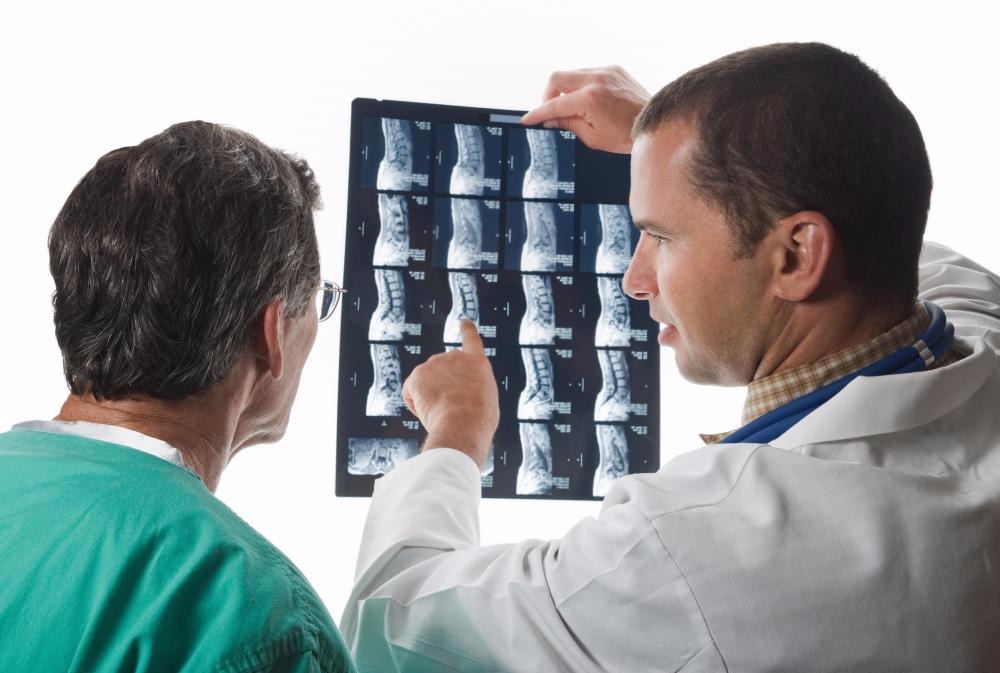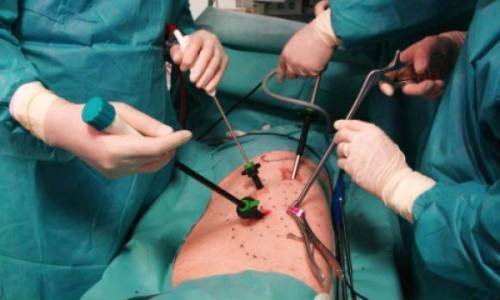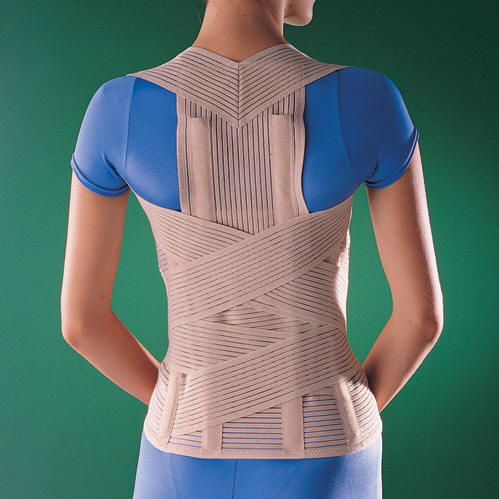Back doctor. Which doctor treats the spine and back, as this specialist is called
- Who makes the diagnosis
- Which doctors are involved in the treatment of spinal hernia
- Initial appeal to the therapist
- Vertebrologist - a doctor who is engaged in the treatment of the spine
- Neuropathologist - a doctor who treats the spine in regional hospitals
- Orthopedic surgeon deals with complicated forms of spinal diseases
- Related Spinal Specialists
- What specialist to contact when spinal curvature is detected
- Treatment by narrow specialists
- Inpatient treatment
Behind medical care for back pain, only a third of patients are treated. Half of them hope that unpleasant symptoms over time will pass.
Meanwhile, back pain is dangerous, there is a risk of developing spinal diseases involving muscles and internal organs . One of these serious pathologies is intervertebral hernia. Many have heard and know about this disease, but anyone far from medicine has no idea which specialist can help. We will tell you who to complain about and which doctor deals with the treatment. intervertebral hernia lumbar and other departments.
Who makes the diagnosis
In our time, with suspected intervertebral hernia, many go for answers on the Internet. Find information, compare symptoms and draw conclusions about the diagnosis. Some go further and begin self-treatment, relying on hundreds of recipes and methods that fill the Internet space. This approach can end sadly.
This is especially true of pathological formations in the lumbar spine. In addition to exacerbation of the disease during self-treatment, there is a risk that other complications will be added to the main diagnosis.
If the symptoms of the disease actively manifest themselves, but you are not sure about the diagnosis, go to the local therapist. It is this specialist who can make the initial diagnosis. Numbness of the extremities, pain in the lumbar spine, weakness, low performance, headaches, problems with the intestines - all these are symptoms of intervertebral hernia, but they can also apply to other diseases. In order to make an accurate diagnosis, the therapist will recommend to take an X-ray picture of the spinal column and pass tests (blood, urine).
After the differential diagnosis of the patient with a presumptive diagnosis of "intervertebral hernia" is sent to see an orthopedist. This doctor treats problems. musculoskeletal system man and solves all issues related to the treatment of the spine. After examining the finished tests, the specialist polls the patient. When were the first symptoms noticed, where it hurts and how often, are the pain accompanied by other complaints? After receiving the answers and making a general picture, the doctor may prescribe additional studies, ultrasound and MRI.
Without restoration of the physiological corset function of the back muscles, it is useless to treat the intervertebral hernia. So, with severe lesions lumbar the whole complex of therapeutic measures and the help of doctors of different specialties are required The final diagnosis is made on the basis of all received data. After that, a treatment plan is made, which usually enters drug therapy , physiotherapy, massotherapy , therapeutic exercise, etc.
Which doctors are involved in the treatment of spinal hernia

In addition to the participation of an orthopedist who controls and, if necessary, corrects the treatment process, the patient will need the help of other doctors.
For the prevention and treatment of hernia, our regular reader uses the increasingly popular method of SECONDARY treatment recommended by leading German and Israeli orthopedists. After carefully reviewing it, we decided to offer it to your attention.
- In case of intervertebral hernia, it is not recommended to engage in self-massage, first of all, it concerns the lumbar region. Wrong movements and ignorance of the intricacies of massaging technology can cause disability. Massage should be done by a professional, qualified manual therapist. A good doctor will speed recovery and help restore the patient’s condition even after surgery.
- With recommended course therapeutic exercises classes are held with the participation of specialists in exercise therapy. Doctors select a set of exercises allowed for intervertebral hernia. This takes into account the patient's age, his physiological and physical characteristics, the presence of other pathologies. Controlled the correctness of the exercises. The specialist is present in the classroom, and in cases of health problems, makes the necessary adjustments to the lesson plan.
- Intervertebral hernia can cause neurological disorders. Neurologists know how to diagnose and treat them, their participation and assistance may be needed.
- Physiotherapy treatments are conducted and monitored by a physiotherapist. Electrophoresis, electrostimulation, ultrasound therapy and other physiotherapeutic methods of treatment make it possible to introduce medical preparations in vertebral tissue without cuts and pricks. They effectively relieve puffiness and inflammation.
- Osteopath care may be required. It is not uncommon for an intervertebral hernia to be accompanied by pathologies such as poor posture, clubfoot or flatfoot.
- AT difficult cases , with hernias running, the patient is prescribed an operation to eliminate the pathological formation. This is an extreme measure, it is resorted to in situations where conservative methods treatment did not bring results. Operational therapy takes place with the participation of surgeons.
Which specialists will take part in the process of treatment of intervertebral hernia and how many will be depends on the degree of development of the pathology. Sometimes consultations and recommendations of the orthopedist are enough, but there are cases when up to 5-6 doctors are included in the treatment process. With such a community of professionals who ensure the restoration of spinal health, the patient has every chance to overcome the disease and forget about it.
Which doctor is engaged in treating the spine
Spinal disease is a fairly common pathology of the musculoskeletal system. The modern lifestyle contributes to the violation of the structure of the vertebrae and intervertebral discs, which leads to the development of scoliosis, osteochondrosis, protrusions and hernias spinal column . The pathological process is accompanied by back pain, impaired sensitivity of the extremities, impaired normal motor activity, and complications from the central nervous system.
Ignoring the problem can lead to disability and significantly reduce the quality of life. That is why it is extremely important to seek help from a specialist at the first manifestations of discomfort in the back.
What doctor treats the spine and how is the treatment of the disease? Let's try to figure it out.
Initial appeal to the therapist
Discomfort in the back can occur not only in the pathology of the spinal column. Disorders of the internal organs, such as the esophagus, stomach, kidneys, heart, and sex glands, can manifest as pain in different parts of the spine. Independently make a diagnosis without having a medical education and experience medical practice is impossible. Even doctors consult with colleagues about their ailments in order to eliminate diagnostic errors. The same applies to treatment, which must be prescribed by a specialist with narrow qualifications.
At the first manifestations of discomfort in the back, you should consult with a therapist.
If your back hurts, you need to find the time as soon as possible and visit the general practitioner of the district clinic. Doctor general practice find out the history of the disease and examine the spinal column. At the reception, the therapist will in detail ask about the manifestations of the disease, the nature pain syndrome will reveal possible reasons the occurrence of pathology. During the external examination, he feels the vertebrae and intercostal spaces, determines the areas of deformity and curvature of the spinal column, the mobility of the axial skeleton and the localization of unpleasant sensations.
The therapist is the first doctor to make a preliminary diagnosis, prescribe additional methods research or immediately refer the patient to the doctors of a narrow specialty. He can hold differential diagnosis with other diseases, confirm or deny the pathology of the spine. The initial treatment in case of back problems should be to this specialist.
Vertebrologist - a doctor who is engaged in the treatment of the spine
A vertebrologist is a specialized medical specialty that deals exclusively with the problems of the spinal column. A qualified doctor has knowledge of functional diagnostics, can read radiographs and tomograms of the spine, has manual therapy and massage techniques, has deep knowledge in the field of physiotherapy exercises and physiotherapy. In his work, the spine uses methods drug treatment , spinal traction, complex rehabilitation after elimination inflammatory response and pain syndrome.
Thus, a specialist narrow focus is a universal doctor for the treatment of diseases of the back. He leads the patient from the start of treatment to the end. recovery period that has a positive effect on recovery. Some doctors of this specialization may perform operations on the spinal column. However, the vertebrologist only accepts large medical centers and regional hospitals, which means that this profession is a rather rare medical specialty. Not all patients from the district centers can afford to be observed by a vertebrologist. How to be in this situation?
Neuropathologist - a doctor who treats the spine in regional hospitals
Small medical institutions in the regional centers, they always have in their staff neuropathologists who are called upon to practice the spine in acute stage diseases and infringement of spinal roots. Usually, therapists refer patients with spinal column problems to an appointment with this specialist.
The task of the neurologist is to reduce inflammation in the area pathological process , eliminate the infringement of the neurovascular bundles, thereby getting rid of intense back pain.
As a result of the therapy, sensitivity and full movements of the extremities are restored, the blood flow through the cerebral arteries is activated, the work of the internal organs is normalized, the general well-being improves. However, the neuropathologist is not a universal specialist and works together with doctors of different qualifications at each stage. therapeutic process . Depending on the phase of the disease and the severity of the pathology, he sends the patient for consultation and therapy to doctors of related specialties.
Orthopedic surgeon deals with complicated forms of spinal diseases
Orthopedic surgeons usually deal with spinal curvatures and operations to remove spinal hernias, osteophytes, and other disorders. anatomical structure axial skeleton. Besides, common cause back problems are flat feet, the treatment of which is within the competence of such specialists.

In neglected clinical cases of spinal column diseases, surgical intervention is carried out.
Spinal hernias, bone growths, kyphosis and scoliosis lead to trauma to the surrounding soft tissue, compression spinal cord , disruption of the functioning of internal organs, which can lead to serious consequences. Holding surgical intervention in such clinical cases is a vital necessity.
Related Spinal Specialists
Who else treats spinal diseases? At the stage of the recovery period, such specialists as physiotherapists, physiotherapy physicians, manual therapists, and massage therapists are included in the therapeutic process. Thanks to these doctors, the metabolism and blood circulation in the pathology area is normalized, the muscular framework of the back is strengthened, it is restored anatomically correct position vertebrae, improves motor activity and returns to work.
In addition, at the stage of final diagnosis, the attending doctor can refer the patient for consultation to a cardiologist, pneumologist, gastroenterologist, gynecologist, nephrologist to exclude diseases of the internal organs.
Many medical specialties may be engaged in the treatment of diseases of the spinal column and complications of the pathology of the musculoskeletal system. The main task of the patient is timely access to a doctor for diagnosis and complex therapy . If your back hurts, you should not postpone visiting a specialist and allow the disease to progress until severe complications appear.
At the initial stage of development, scoliosis occurs without pain symptoms and pronounced discomfort in the back.
His appearance is most often recognized by visible changes in the shape of the spinal column: a close examination of the patient's back may show that one shoulder is above the second, the waistline is smoothed on one side, and asymmetry is observed in the arrangement of the shoulder blades. In some cases, small dimples are noticeable on the back, and a muscular ridge appears in the lumbar region. These symptoms indicate that you need to schedule a hospital visit.
What specialist to contact when spinal curvature is detected
The first person to contact if you have a back problem in an adult is family doctor the therapist, and if found in the child, you need to go to the pediatrician. You can get advice from him which doctor treats scoliosis in your city. Having made a primary inspection, diagnostic studies and having determined the disease, the therapist (pediatrician), depending on the symptomatic manifestations, refers the patient to narrow specialists.
Doctors involved:
- Therapist;
- Neuropathologist;
- Traumatologist orthopedist;
- Surgeon, neurosurgeon;
- Vertebrologist.
The final decision on who will treat the patient with spinal curvature is made on the basis of an x-ray examination. If a patient is diagnosed on the basis of images, therapist deals with the treatment. If necessary, consultations with a neurologist and orthopedist are appointed, but the appointment will be made by the attending physician. With more serious changes in the bone structure, the therapist (pediatrician) directs the patient to a narrowly focused specialist in the treatment of spinal diseases.
Treatment by narrow specialists
If a integuments lose sensitivity, there are violations of the reflex contractions of the tendon ligaments, pain in the spine and muscle tissue back, the patient is sent for treatment to a neurologist. Even if these symptoms are not observed, consultation with a neurologist is required.
A spine doctor specializes in the treatment of spinal diseases, including curvature. A qualified vertebrologist has knowledge of an orthopedist, a neurologist, a surgeon and other narrowly focused specialists, therefore, he can diagnose the disease and prescribe treatment without further consultation. Vertebrologists work in large private or public clinics, and they do everything possible to work with patients so that the treatment can be done without surgery.
If it is not possible to get the help of a vertebrologist, the orthopedist will restore the bone and articular system in the early stages of the spinal curvature. In the course of treatment, depending on the condition of the patient, he refers the patient to auxiliary specialists.

Scoliosis Corset
Methods used to treat scoliosis:
For the prevention and treatment of skolioza and curvature of the spine, our regular reader uses the increasingly popular method of non-surgical treatment recommended by leading German and Israeli orthopedists. After carefully reviewing it, we decided to offer it to your attention.
- Massage;
- Physiotherapy;
- Physiotherapy;
- Manual therapy
If after examining the patient is diagnosed, or treatment does not bring positive results , further assistance is provided in the hospital: hospitals, private clinics, research institutes.
Inpatient treatment
In inpatient facilities, patients are under the supervision of narrow specialists, including neuropathologists, vertebrologists and orthopedic traumatologists. Here, patients are provided with more qualified care, including a course of anti-inflammatory and analgesic therapy. Besides drugs , patients are assigned a complex amount of procedures designed to affect the parts of the spine that have been deformed.
In some cases, the effect in restoring the curved spine is achieved only long wearing Corset - a method rather uncomfortable for the patient, especially the child, but effective.
When conservative treatment does not bring results or the disease continues to progress, there is a threat to the normal functioning of the internal organs. At this stage of the disease, the surgeon deals with the treatment. Operational methods treatments are applied in extreme cases when all possible ways , and the disease goes into stages 3 and 4. The essence of the operation is to return the spine to its normal position with the help of metal elements fixing the vertebrae at the right angle. Often surgical treatment curvature is carried out in stages, gradually correcting the defects of the spinal column.
What doctor treats the spine and how is the treatment of the disease?
How to be in this situation?